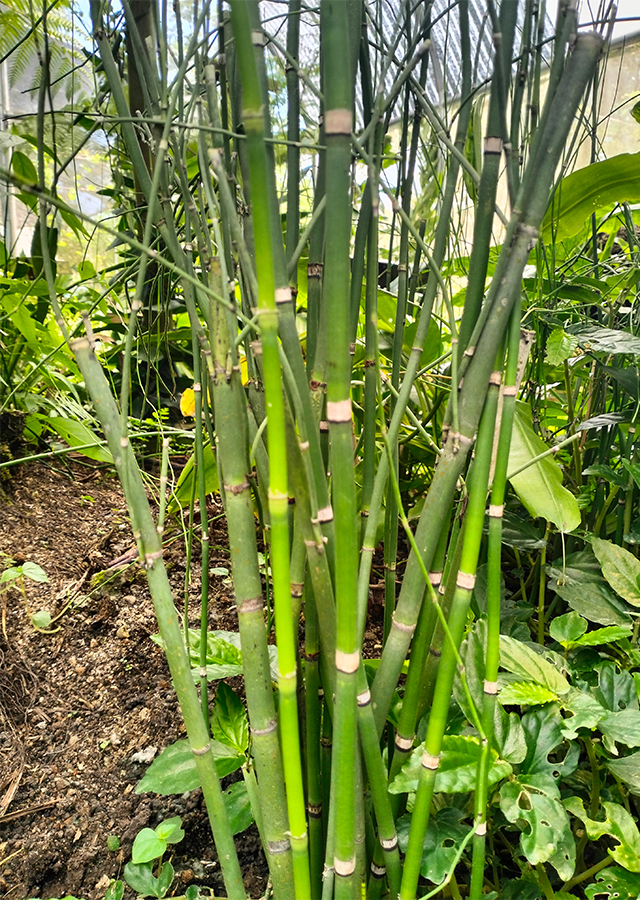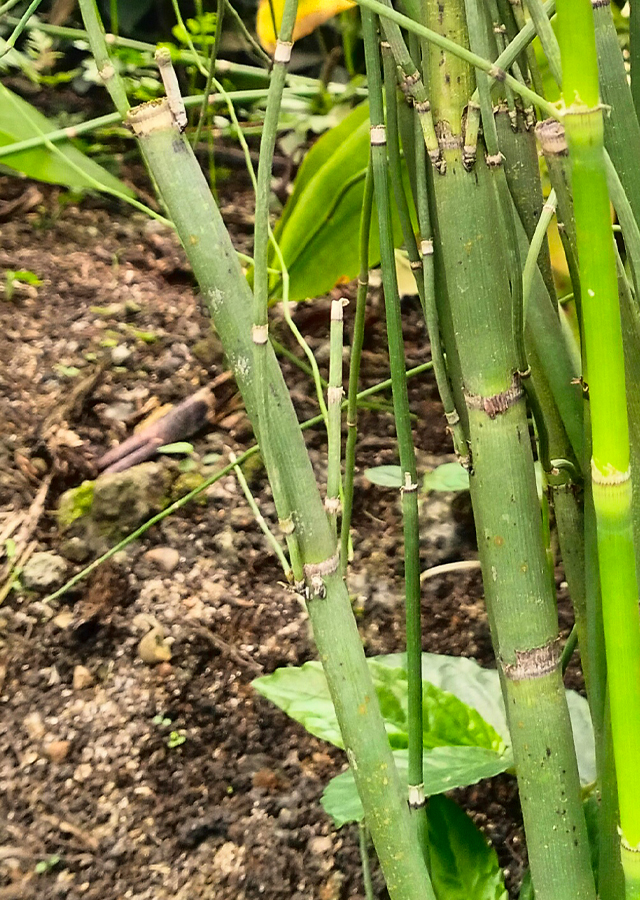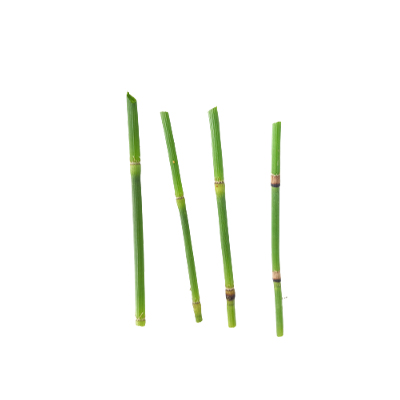Scouring Rush
Equisetum hyemale L.
Equisetaceae
Location in our garden
Aquatic



Synonym
Equisetum hyemale f. hondae (Satou) Nakaike
Hippochaete hyemalis (L.) Milde ex Bruhin
Habitus
Fern. Perennial fern, 1-2 m high
Part Used
Stem
Growing Requirements
Full Sunshine
Need Shade
Habitat
Aquatic
Wetland
Overview
Equisetum is the single surviving genus of a class of primitive vascular plants dating back to the mid Devonian period (350+ million years ago). Equisetums are categorized as allies of ferns largely because they, like ferns, are non-flowering seedless plants that reproduce by spores. Equisetum hyemale is native to Eurasia, North America. One common name is "Scouring Rush," because the stems are so rich in silica that they are used for scrubbing dishes. In Mexico, this plant is grown for the purpose of polishing furniture. In the floriculture industry, nowadays it has been widely planted as potted and garden ornamental plants. This plant is also used as medicine and has environmental uses as phytoremediation.
Vernacular Names
No data found on this. Need further research.
Agroecology
Prefers moist soil with a pH between 6.5 and 7.5, in direct sunlight or partial shade. Perforated grass is resistant to temperatures around -30 °C.
Morphology
- Roots - branching, creeping rhizome, sometimes small tubers are produced along the rhizome.
- Stems - spherical, thin stems having a grooved surface, the hollow circumpolar sphenopsid covers at least two-thirds of its diameter. Stem above the water surface, monomorphic, green, with a height of more than 1 m. The stem diameter is between 0.5-1 cm, the base of the stem is not branched but has lateral branches with a length of 5-8 cm. Stems generally have serrations with the number of 16-22 serrations depending on the diameter of the stem. The stem color is green with two black bands at the rush joint.
- Leaves - small, grayish leaves (with tooth-like margins) completely surround and grip the stem in the knuckles, forming a sheath-like structure. Thin black bands appear just above and below the leaf.
- Spores - nipple-like cone bearings. Equisetum spores can germinate quickly under conditions suitable for high humidity.
Cultivation
- Reproduction can be done by spores and division of rhizomes.
- Spores - best collected as soon as they are ripe and immediately sprinkled on the surface over sterile compost. Keep the soil moist and transfer it to the pot as soon as the plant is big enough. Propagation by spores has a high level of difficulty.
- Divisions - plants usually spread very freely when well placed, so they are easily propagated by separation from the parent.
Chemical Constituents
Flavonoids, polyphenols, alkaloids, silica, ethyl palmitate, kaempferol, glycosides and other phenolic compositions.
Traditional Medicinal Uses
- Treat edema, kidney and bladder problems.
- Stop wound bleeding and promote healing.
- Fight various types of infectious or inflammatory diseases such as rheumatoid arthritis, conjunctivitis, pyelonephritis.
- Treat tuberculosis, jaundice, prostatitis, hypertension.
- This plant is anticancer, anti-inflammatory, antispasmodic, diaphoretic, diuretic, expectorant, fever-reducing, hemostatic, hypotensive, and styptic.
Part Used
Reference Sources
- Royal Botanic Gardens. Plants of the World Online: Equisetum hyemale L.. https://powo.science.kew.org/taxon/urn:lsid:ipni.org:names:92939-2#descriptions. 15-08-22.
- Useful Tempetare Plants. 2022. Equisetum hyemale. http://temperate.theferns.info/plant/Equisetum+hyemale. 15-08-22.
- Flora Fauna Web. 2021. Equisetum hyemale. https://www.nparks.gov.sg/florafaunaweb/flora/1/5/1550. 15-08-22.
- BALITHI. 2019. KLASIFIKASI DAN DESKRIPSI BOTANI EQUISETUM HYEMALE L. http://balithi.litbang.pertanian.go.id/berita-627-klasifikasi-dan-deskripsi-botani-equisetum-hyemale-l.html#. 15-08-22.
